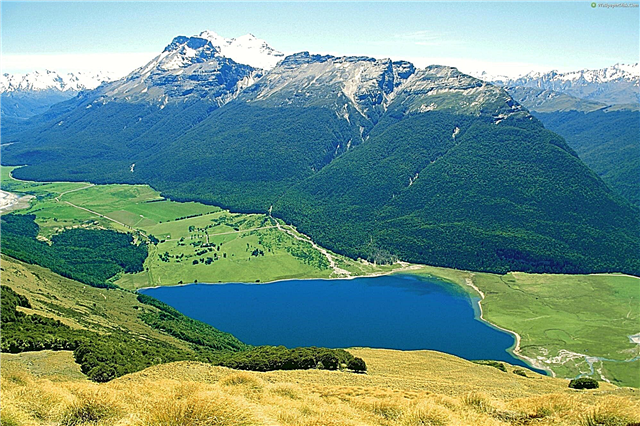Niagara Falls is one of the most beautiful natural phenomena in the world. He bewitches with his majesty and power. Hundreds of travelers from all over the world come every day to where this amazing and unique natural monument is located.
General information about Niagara Falls
Niagara Falls is a complex of three waterfalls. It is located on the border of two states: the USA (New York State) and Canada (Ontario) on the river of the same name. The coordinates of this place are 43.0834 degrees north latitude and 79.0663 degrees west longitude. The waterfall connects the lakes that are part of the North American Great Lakes: Erie and Ontario. On the banks of the Niagara River, next to a waterfall on the side of both countries, there are two cities with the same name Niagara Falls.
Going to Niagara Falls, you should think about your route in advance, since you can get here in two ways: by flying to New York, or to the Canadian city of Toronto. Excursions are organized from both cities, but it is not at all necessary to take them, since you can get there on your own by regular buses.
Each of the three cascades of Niagara has its own name. Waterfalls located in the United States are called "American" and "Fata". There is Horseshoe Falls in Canada.
Cascades of water rush down from a height of just over 50 meters, but the visible part is only 21 meters due to the piling up of stones at the foot. Niagara is not among the tallest waterfalls in the world, but due to the huge volumes of water passing through it, it is considered one of the most powerful on Earth. In one second, it passes through itself more than 5.5 thousand cubic meters of water. The width of the Horseshoe Falls is 792 meters, the American Falls - 323 meters.
The climate in the area of the waterfall is moderately continental. In summer it is quite warm here, and sometimes it is hot, in winter the temperature is below zero, and the waterfall partially freezes. You can come here all year round, because in any season it is beautiful in its own way.
The waters of Niagara are actively used to provide energy to nearby regions of Canada and the United States. Several hydroelectric power plants have been built on the river bank.
History of origin and name
The Niagara River and the Great North American Lakes appeared about 6,000 years ago. Their formation was provoked by the Wisconsin glaciation. As a result of the movement of the glacier, which swept away everything in its path, the relief of this area completely changed. The channels of the rivers flowing in those parts were filled up, and in some, on the contrary, they were widened. After the glaciers began to melt, waters from the Great Lakes began to drain into Niagara. The rocks that formed its bottom were soft in places, so the water washed them away, forming a steep cliff - and this is how the famous natural landmark in the form of a waterfall appeared.
The first mentions of Niagara Falls date back to the beginning of the 17th century. In 1604, the mainland on which the waterfall is located was visited by the expedition of Samuel de Champlain. He later described this natural site in his journal from the words of other participants in the trip. Personally Champlain did not see the waterfall. Six decades later, a detailed description of Niagara Falls was compiled by the Catholic monk Louis Ennepin traveling in North America.
The word "Niagara" is literally translated from the language of the Iroquois Indians, as "the sound of water." It is believed that the waterfall is named after the indigenous peoples who lived nearby, the Onigara tribe.
Extreme or madness
Since the time when it became fashionable to travel, or rather from the beginning of the 19th century, tourists began to come to the shores of Niagara Falls. Some of them wanted not only to see the unique miracle of nature, but also to try to get through it.
The first to do it was American stuntman Sam Patch. He jumped into the Niagara River at the foot of the falls in November 1929 and survived. Sam was preparing for the jump, information about the upcoming trick appeared long before his execution. The event, according to his plans, was to be attended by a lot of people. However, bad weather conditions marred the stuntman's performance. There were not many people gathered, and the received fee did not suit Patch. Therefore, exactly one week later, he promised to repeat the jump. However, the second attempt of the daredevil to conquer Niagara ended sadly. Sam did not surface, and his body was found only a few months later.
In 1901, 63-year-old American extreme sportswoman Annie Taylor decided to climb the falls while sitting in a barrel. In such an unusual way, the lady wanted to celebrate her birthday. The woman managed to survive, and her name went down in history.
After this incident, the thrill-seekers periodically tried to conquer Niagara Falls. The authorities even had to impose a ban on such tricks. However, the daredevils threw themselves from the waterfall every now and then. Many of them died, and those who survived were fined.
An interesting fact is the miraculous rescue of a seven-year-old boy named Roger Woodward, who was accidentally carried into Niagara Falls. He was wearing only a life jacket, but nevertheless the child managed to survive.
Excursions and entertainment
Mostly tourists come to Niagara to visit the waterfall itself. This can be done both from the American side and from the Canadian side. There are several viewing platforms from which you can take stunning photos of water streams falling down. The most impressive pictures can be seen from the Table Rock observation deck.
Those who want to take a closer look at the attraction and even feel the spray of jets on themselves should take a ride on pleasure boats. Tourists are taken in turn to each of the three cascades. Before boarding a pleasure boat, everyone is given a raincoat, but even it will not save you from the powerful jets of Niagara Falls. The most spectacular is the Horseshoe Falls.
Another excursion that will certainly be remembered invites travelers to find themselves behind the waterfall. You can also fly over this unique natural site by helicopter or hot air balloon. The only disadvantage of this kind of entertainment is the rather high price.
You should definitely take a walk along the Rainbow Bridge, located a few hundred meters from the main attraction of Niagara. In clear weather, the bridge can be seen from the observation platforms.
The Niagara Falls area is home to museums, national monuments and parklands. Queen Victoria Park is especially popular with tourists. It is located in Canada. Here you can walk among the flowers and trees, sit in a cafe and see the main attraction of this area from the observation deck.
The nearby museums are devoted mainly to the history of the discovery and interesting facts related to Niagara Falls. In them you can see a collection of objects on which desperate daredevils tried to conquer the waterfall. And also wax figures of people whose life is somehow connected with the famous natural monument.
We recommend seeing Angel Falls.
Niagara Falls is also interesting to see at night. At night, a real light show takes place here. The jets are illuminated with different colors using spotlights. All this looks truly fabulous.
In winter, the waterfall is no less beautiful. Niagara is a partially freezing waterfall. Only its edges are covered with ice. In the middle of the cascade, water continues to flow down all year round. For the entire time of the known history of the waterfall, due to abnormally low temperatures, it froze three times completely. Of course, you won't be able to take a boat trip to Niagara in winter, but at this time of the year you can watch a colorful fireworks festival. The illumination of the waterfalls these days is turned on almost round the clock, and multi-colored fireworks soar into the sky.
Niagara Falls is one of the most imposing and vibrant natural sites in the world. Its beauty will not leave indifferent even the most sophisticated tourists. Once at its foot, it is impossible not to feel the full strength and power of this natural phenomenon. The developed infrastructure near the object will make it possible to spend a trip vividly and remember it for a lifetime.









